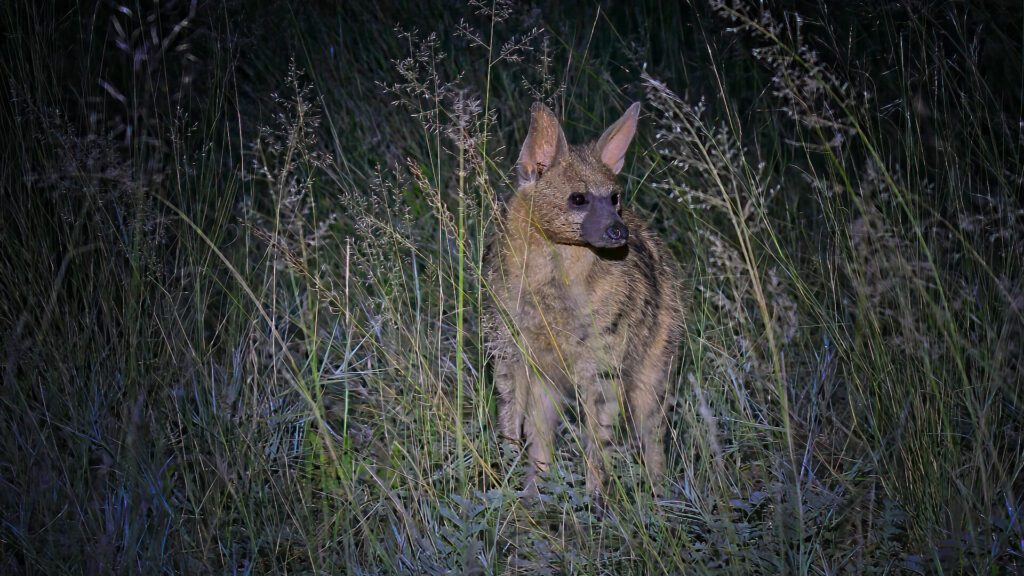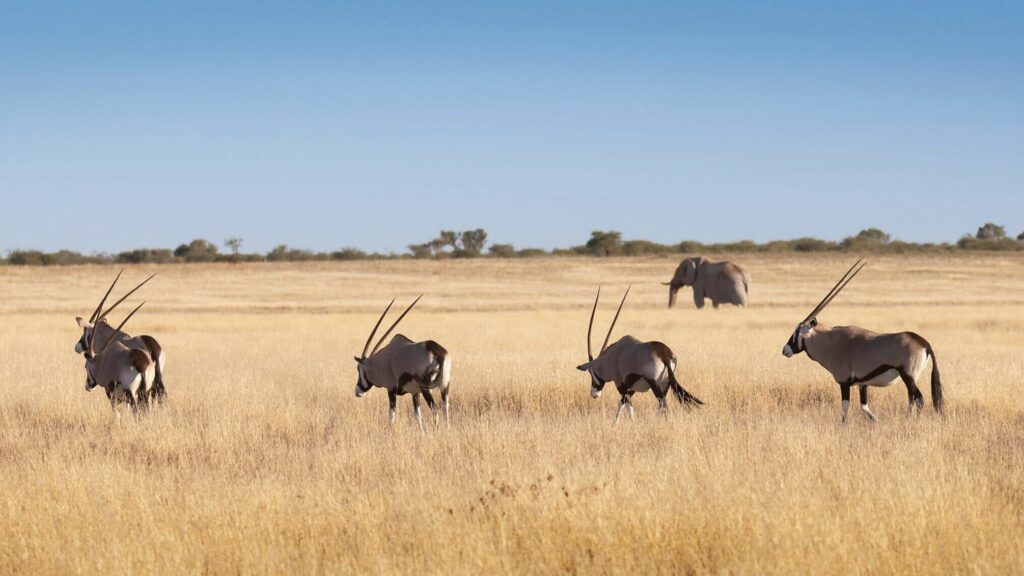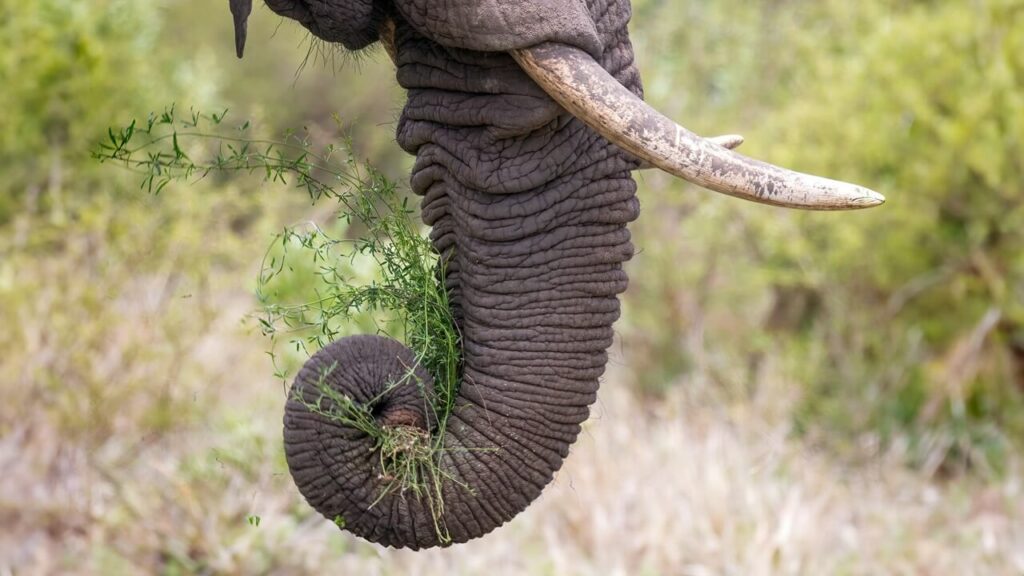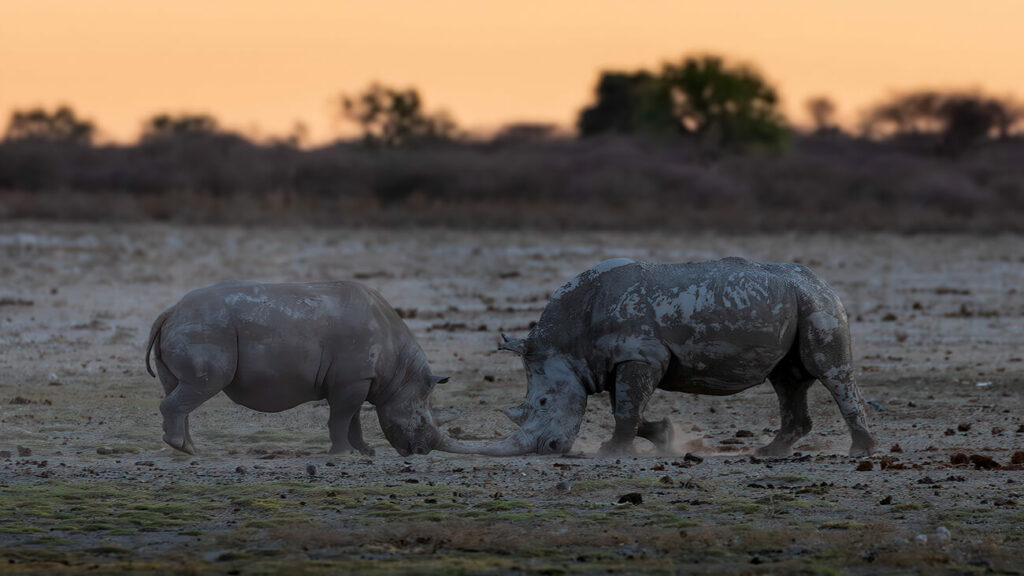Aardwolf in the Kalahari
Aardwolf: The Kalahari’s Termite-Loving Enigma
The Aardwolf is a small, nocturnal mammal that is found in the arid and semi-arid regions of Africa. It is a member of the hyena family and is known for its unique diet of primarily termites. In the Kalahari desert, the Aardwolf is known to thrive in the harsh desert environment, thanks to its ability to survive without water for long periods of time, a key adaptation that allows it to thrive in the Kalahari’s harsh conditions.

Aardwolf seen at Khamab Kalahari Reserve
Quickfire Aardwolf facts:
- Weight: Adult aardwolves typically weigh between 10-15 kg (22-33 lbs)
- Speed: Aardwolves are not fast runners, with a top speed of around 40 km/h (25 mph)
- Diet: Aardwolves have a highly specialized diet, consisting mainly of termites, specifically harvester termites. They are able to consume up to 300,000 termites in a single night, using their long, sticky tongue to extract the insects from their mounds. They also occasionally eat other insects, small mammals, and fruit.
- Threats: Aardwolves are considered to be of least concern by the International Union for Conservation of Nature (IUCN), however, they do face some threats, such as habitat loss and fragmentation, which can lead to a reduction in termite populations and competition with other predators for food.
- Social Behavior: Aardwolves are generally solitary animals, however, during mating season they may form temporary pairs. They are territorial and mark their territory with urine and gland secretions. They are not known to be vocal animals.
- Reproduction: Aardwolves typically breed once a year, with a gestation period of around 90 days. Litters typically contain 2-4 pups, which are born in underground burrows. The young are weaned at around 6-8 weeks of age and are independent at 4 months of age but typically remain in the same den as their mother until the next breeding season.
Aardwolf: The Kalahari’s Termite-Loving Enigma
The Aardwolf (“earth wolf” in Afrikaans) is a truly unique creature. This small, hyena-like mammal thrives in the Kalahari Desert, defying expectations with its specialized diet and fascinating adaptations. Let’s dive into its world!
Taxonomy and Origins: Meet the Unusual Hyena
The Aardwolf (Proteles cristata) is the sole surviving member of its subfamily (Protelinae) within the hyena family (Hyaenidae). Its lineage is ancient, with fossils suggesting aardwolves have roamed Africa for millions of years!
Size and Appearance: Not Your Typical Hyena
Aardwolves are much smaller than their spotted or striped hyena cousins. They weigh 7.9 – 12 kg (18-26 lbs) and stand around 50 cm (20 inches) tall at the shoulder. Their fur is striped, giving them a passing resemblance to hyenas, but their long, thin legs and bushy tail are distinctly their own.
Built for Termites, Not Speed
Aardwolves aren’t built for chasing prey. Its top speed is around 40 km/h (25 mph), reserved for short bursts. However, they can devour up to 300,000 termites in a single night! Their long, sticky tongue and powerful jaws are perfect for slurping up insects.
Social Lives: Solitary, but Not Entirely
Aardwolves are primarily solitary, but their social structure is more complex than once thought. They maintain territories marked with scents and may pair up during breeding season. While they forage alone, family groups can sometimes be seen sharing dens.
Temperament: Shy and Elusive
Aardwolves are known for their timid nature. They prefer to avoid confrontation, relying on their excellent hearing and sense of smell to detect potential threats. When cornered, they may raise their manes and emit a foul-smelling secretion as a defense.
Reproduction: Raising the Next Generation
Aardwolves typically breed once a year, with a gestation period of about 90 days. Females give birth to 2-4 pups in underground dens. Pups stay with their parents for several months, learning essential survival skills.
Distribution: Where to Find the Aardwolf
Historically, the Aardwolf had a wider range across sub-Saharan Africa. Today, it’s found in two distinct populations: one in southern Africa and one in East Africa. They primarily inhabit grasslands, savannas, and the arid Kalahari.
The Kalahari Connection: A Termite Paradise
The Kalahari Desert might seem like an unlikely home for the Aardwolf, but it’s teeming with termites – its favorite food! The Aardwolf has clever adaptations to survive in this harsh environment, including water-conserving kidneys and large ears to help it stay cool.
Threats and Conservation: Not Out of the Woods
While listed as “Least Concern” by the IUCN, the Aardwolf faces threats. Habitat loss due to agriculture and development fragments its habitat. It is sometimes persecuted by farmers due to a mistaken belief that it preys on livestock.
FAQs: Your Aardwolf Questions Answered
The Value of the Aardwolf: More Than Meets the Eye
The Aardwolf isn’t just fascinating – it’s essential to ecosystems! It controls termite populations, and its abandoned dens provide shelter for other species. By understanding and appreciating the Aardwolf, we help protect it and the delicate balance of the Kalahari.
Remember: Every Observation Counts!
Spotting an Aardwolf is a special treat. Sharing these sightings with researchers helps us better understand and protect this termite-loving enigma.
Want to see an Aardwolf for yourself? Our Project let’s you join a Kalahari Safari to help African Wildlife or Contact Us for any other questions or read our Testimonials!
Learn more about Aardwolves here.






